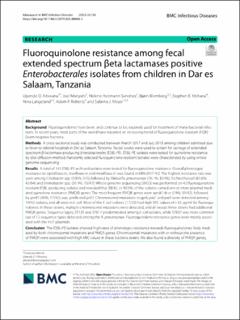| dc.description.abstract | Background: Fluoroquinolones have been, and continue to be, routinely used for treatment of many bacterial infections. In recent years, most parts of the world have reported an increasing trend of fluoroquinolone resistant (FQR) Gram-negative bacteria.
Methods: A cross-sectional study was conducted between March 2017 and July 2018 among children admitted due to fever to referral hospitals in Dar es Salaam, Tanzania. Rectal swabs were used to screen for carriage of extended-spectrum β-lactamase-producing Enterobacterales (ESBL-PE). ESBL-PE isolates were tested for quinolone resistance by disk diffusion method. Randomly selected fluroquinolone resistant isolates were characterized by using whole genome sequencing.
Results: A total of 142 ESBL-PE archived isolates were tested for fluoroquinolone resistance. Overall phenotypic resistance to ciprofloxacin, levofloxacin and moxifloxacin was found in 68% (97/142). The highest resistance rate was seen among Citrobacter spp. (100%, 5/5), followed by Klebsiella. pneumoniae (76.1%; 35/46), Escherichia coli (65.6%; 42/64) and Enterobacter spp. (31.9%; 15/47). Whole genome sequencing (WGS) was performed on 42 fluoroquinolone resistant-ESBL producing isolates and revealed that 38/42; or 90.5%, of the isolates carried one or more plasmid mediated quinolone resistance (PMQR) genes. The most frequent PMQR genes were aac(6’)-lb-cr (74%; 31/42), followed by qnrB1 (40%; 17/42), oqx, qnrB6 and qnS1. Chromosomal mutations in gyrA, parC and parE were detected among 19/42 isolates, and all were in E. coli. Most of the E. coli isolates (17/20) had high MIC values of > 32 µg/ml for fluoroquinolones. In these strains, multiple chromosomal mutations were detected, and all except three strains had additional PMQR genes. Sequence types, ST131 and ST617 predominated among E. coli isolates, while ST607 was more common out of 12 sequence types detected among the K. pneumoniae. Fluoroquinolone resistance genes were mostly associated with the IncF plasmids.
Conclusion: The ESBL-PE isolates showed high rates of phenotypic resistance towards fluoroquinolones likely mediated by both chromosomal mutations and PMQR genes. Chromosomal mutations with or without the presence of PMQR were associated with high MIC values in these bacteria strains. We also found a diversity of PMQR genes, sequence types, virulence genes, and plasmid located antimicrobial resistance (AMR) genes towards other antimicrobial agents. | en_US |

